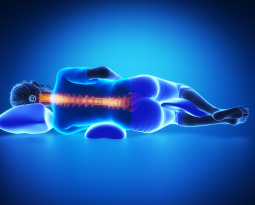
Sleep Apnea: Your posture may be strangling you while you sleep
Sleep Apnea: Your posture may be strangling you while you sleep
According to the CDC an estimated 50-70 million US adults have sleep disorder. This ranges from snoring to the most common problem being Obstructive Sleep Apnea (OSA). OSA is actually caused by a blockage of the airway in the throat that closes, cutting off air supply and leaving the sufferer without air for up to a minute at a time. This can occur 100 times or more a night. The American Sleep Apnea Association states that if “left untreated, sleep apnea can have serious and life-shortening consequences: high blood pressure, heart disease, stroke, automobile accidents caused by falling asleep at the wheel, diabetes, depression, and other ailments”. It has been noted that one of the most influential causes of this disorder is sleeping posture.
Obstructive Sleep Apnea is caused by incorrect sleeping posture.
As a person sleeps they assume a resting posture. This can affect many aspects of a persons rest, from muscle fatigue or soreness, restlessness, and difficulty sleeping. With OSA the issue is directly related to the persons posture while sleeping. Studies have shown that sleeping on ones back with high pillows puts the head forward closing off or restricting the airway. This is also a major cause for snoring. The findings have shown that by changing the posture to lying on your side, with the correct level of pillow, that sleep apnea can be completely eliminated. For extreme cases of sleep apnea a more upright/seated posture, using a prop cushion has shown to also remove this issue.
However it is important to assume the correct posture even in these positions. The spine should be level in all sleep positions; the most common error of this is using a pillow that is either too high or too low. Ensure that your head and neck are level with the rest of your spine. It is also beneficial to place a pillow or support between the knees/legs to remove stress from the hips, pelvis and low back.
When the sleeping posture involves a forward flexed neck it restricts the normal function of the airways. This causes the soft tissues of the throat to be tightened, restricting the ability for air to pass. This also causes tension on the spine. You spend 1/3 of your life in bed. Sleeping in this position continually results not only in breathing problems, and restless sleep, but also in postural distortion patterns of the spine and neck. These can increase the likelihood of pain and disc degeneration. Posture is important while sitting, standing, and also sleeping.
Check in what position you most commonly fall asleep and wake up in. This should give you a good idea of your sleeping position. (If you are still unsure you can use a video camera to record yourself, and view how you commonly sleep, and if you are restless or peaceful). Discovering your sleeping posture then allows you to adjust the position, as well as correct for proper posture. To know for sure if your sleeping posture is causing postural distortion patterns get a specific analysis with the American Posture Institutes Posture Diagnosis Online at www.AmericanPostureInstitute.com
4 Posture Tips to resolve your Obstructive Sleep Apnea
- Change your sleeping position
- Place a fanny pack with 2 tennis balls around your waist so that the tennis balls are placed in your low back or stomach, depending on which incorrect sleeping position you has. This will help keep you from rolling over on to your back or stomach while sleeping, and eventually train your habit to sleep on your side.
- Retrain your breathing pattern
- Most people breath with their chest instead of correctly breathing with their diaphragm (belly). Stand up straight in good posture; place one hand on your belly button, and one hand on your chest. Breath deeply and slowly, focusing on expanding the belly without moving your chest. This is the correct way to utilize diaphragmatic breathing.
- Sleep with a correct Posture Pillows
- You spend 1/3 of your life in bed; invest in a good cervical supportive pillow. It does not need to be the most expensive. It just needs to support the head allowing your cervical spine to be in proper alignment with the rest of your spine.
- Use a Sleeping Wedge
- A more extreme alternative to help with OSA is to use a sleeping wedge to force your self into a more upright sleeping position. This would only be recommended if correct side posture sleeping has not completely resolved the problem.
To find out if you are developing postural distortion patterns get a Posture Diagnosis Online at the AmericanPostureInstitute.com. To contact Doctor Wade for more information on how your posture may be causing your health problems, how to stay healthy through proper posture, or for more ways to improve your posture email us at: API@AmericanPostureInstitute.com.
References:
- The effect of body posture on sleep-related breathing disorders: facts and therapeutic implications. Arie Oksenberg, 1, , Donald S. Silverberg2 Sleep Medicine Reviews. Volume 2, Issue 3, August 1998, Pages 139–162
- S E Martin, I Marshall, and N J Douglas “The effect of posture on airway caliber with the sleep-apnea/hypopnea syndrome.” American Journal of Respiratory and Critical Care Medicine, Vol. 152, No. 2 (1995), pp. 721-4. doi: 10.1164/ajrccm.152.2.7633733
- The effects of posture on obstructive sleep apnea. McEvoy RD, Sharp DJ, Thornton AT. The American Review of Respiratory Disease [1986, 133(4):662-666]
- The American Sleep Apnea Association. http://www.sleepapnea.org/learn/sleep-apnea.html
- Center for Disease Control: Insufficient Sleep is a Public Health Epidemic. http://www.cdc.gov/features/dssleep/















